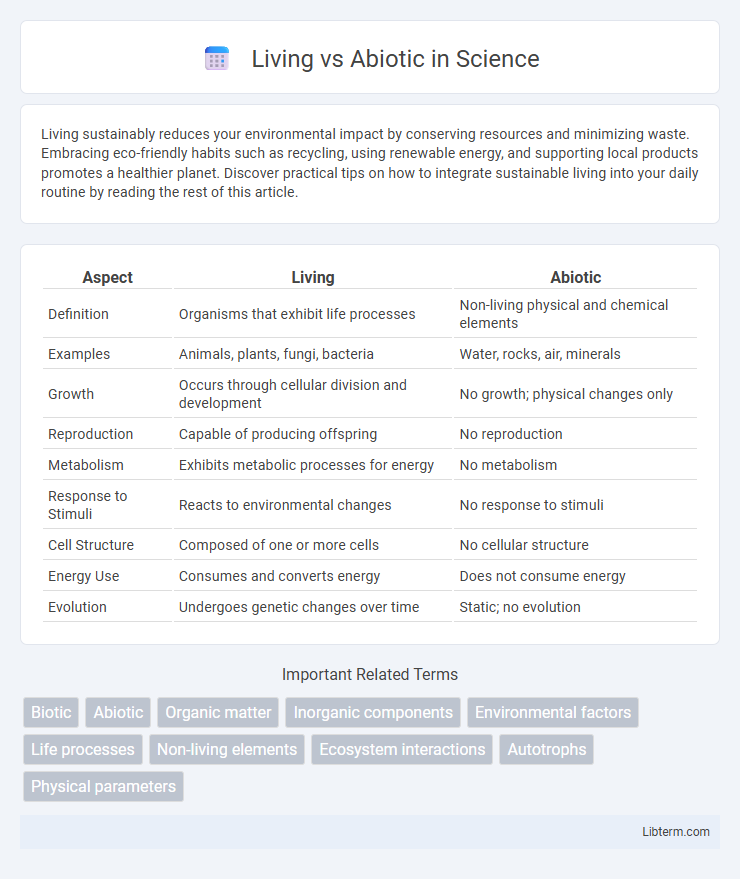Living sustainably reduces your environmental impact by conserving resources and minimizing waste. Embracing eco-friendly habits such as recycling, using renewable energy, and supporting local products promotes a healthier planet. Discover practical tips on how to integrate sustainable living into your daily routine by reading the rest of this article.
Table of Comparison
| Aspect | Living | Abiotic |
|---|---|---|
| Definition | Organisms that exhibit life processes | Non-living physical and chemical elements |
| Examples | Animals, plants, fungi, bacteria | Water, rocks, air, minerals |
| Growth | Occurs through cellular division and development | No growth; physical changes only |
| Reproduction | Capable of producing offspring | No reproduction |
| Metabolism | Exhibits metabolic processes for energy | No metabolism |
| Response to Stimuli | Reacts to environmental changes | No response to stimuli |
| Cell Structure | Composed of one or more cells | No cellular structure |
| Energy Use | Consumes and converts energy | Does not consume energy |
| Evolution | Undergoes genetic changes over time | Static; no evolution |
Definition of Living and Abiotic Components
Living components include organisms such as plants, animals, fungi, and microorganisms that carry out metabolic processes, reproduce, grow, and respond to stimuli. Abiotic components consist of non-living physical and chemical elements like sunlight, water, soil, temperature, and minerals that influence the ecosystem. Both living and abiotic factors interact dynamically, shaping environmental conditions and biological communities.
Key Differences Between Living and Abiotic Factors
Living factors, also known as biotic factors, include organisms such as plants, animals, bacteria, and fungi that exhibit growth, reproduction, metabolism, and response to stimuli. Abiotic factors encompass non-living physical and chemical elements like temperature, sunlight, water, soil, and air that influence ecosystems but do not possess life processes. Key differences lie in biotic factors' ability to sustain life functions and interact biologically, whereas abiotic factors provide the environmental conditions necessary for survival without exhibiting life characteristics.
Examples of Living Organisms vs Abiotic Elements
Living organisms include plants like oak trees, animals such as wolves, fungi like mushrooms, and microorganisms including bacteria and protists. Abiotic elements consist of non-living components such as sunlight, water, minerals, temperature, and atmospheric gases like oxygen and carbon dioxide. These abiotic factors are crucial for maintaining ecosystems, influencing the survival and growth of living organisms.
Role of Living Organisms in an Ecosystem
Living organisms play a crucial role in ecosystems by facilitating nutrient cycling, energy flow, and maintaining ecological balance through interactions like predation, symbiosis, and decomposition. They contribute to soil fertility, regulate climate, and support biodiversity, which abiotic factors alone cannot sustain. The dynamic relationships among living organisms ensure ecosystem resilience and productivity, highlighting their indispensable function in natural environments.
Importance of Abiotic Factors in the Environment
Abiotic factors such as temperature, sunlight, water, and soil minerals play a crucial role in shaping ecosystems by influencing the survival and distribution of living organisms. These non-living components regulate nutrient cycles, energy flow, and habitat conditions essential for plant growth, animal behavior, and microbial activity. Understanding abiotic factors helps predict environmental changes and supports effective conservation and resource management strategies.
Interactions Between Living and Abiotic Components
Living organisms depend on abiotic components such as sunlight, water, air, and minerals for survival, growth, and reproduction. These abiotic factors influence ecosystems by regulating temperature, nutrient cycling, and habitat conditions, shaping species distribution and behavior. Interactions between living and abiotic elements drive biogeochemical cycles, sustaining ecosystem stability and biodiversity.
Impact of Abiotic Changes on Living Organisms
Abiotic changes such as temperature fluctuations, changes in pH levels, and variations in water availability significantly impact living organisms by altering their metabolic rates, distribution, and reproductive success. For example, prolonged drought conditions can reduce food sources and habitat for terrestrial species, leading to population declines and shifts in community structure. These environmental stressors drive evolutionary adaptations and influence ecosystem stability and biodiversity.
Adaptations of Living Things to Abiotic Conditions
Living organisms exhibit specialized adaptations to survive abiotic factors such as temperature, water availability, and soil composition. For example, desert plants have developed thick cuticles and deep root systems to conserve water under arid conditions. Similarly, animals in cold climates possess insulating fur and hibernation behaviors that optimize energy use in freezing temperatures.
Influence of Human Activity on Abiotic and Living Elements
Human activities significantly alter abiotic elements such as soil composition, water quality, and atmospheric conditions, directly impacting ecosystems' health. Urbanization, pollution, and deforestation disrupt natural habitats, causing changes in temperature, nutrient cycles, and availability of resources essential for living organisms. These modifications affect biodiversity, species distribution, and ecosystem services, demonstrating the interconnected influence of human actions on both living and non-living components of the environment.
Balancing Living and Abiotic Factors for Ecosystem Health
Balancing living organisms and abiotic factors such as sunlight, water, temperature, and soil nutrients is crucial for sustaining ecosystem health. Proper equilibrium ensures that biotic components like plants, animals, and microbes can thrive while abiotic elements maintain conditions necessary for life processes. Disruptions in this balance often lead to decreased biodiversity, altered nutrient cycling, and reduced ecosystem resilience.
Living Infographic

 libterm.com
libterm.com